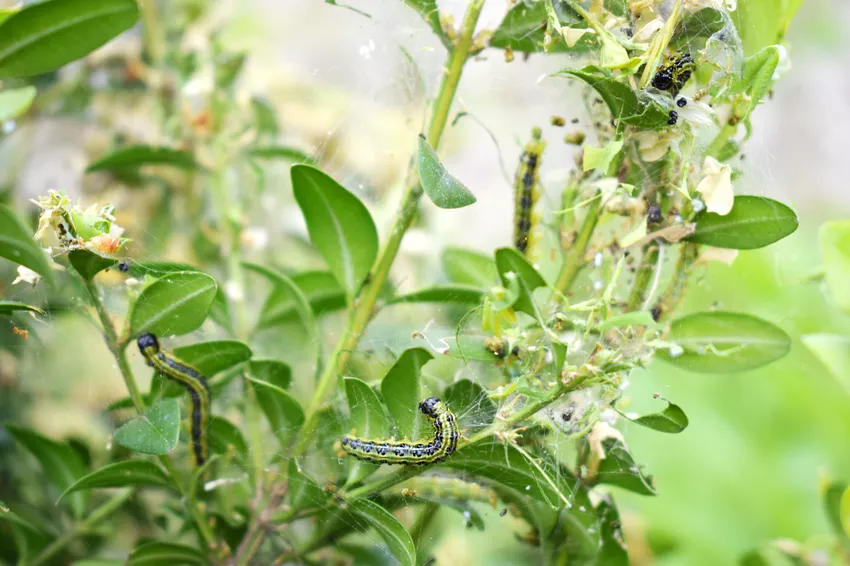- What does the box tree moth look like?
- How do I recognize the infestation?
- Which regions are affected?
- What countermeasures are there?
- What to do if the box tree moth cannot be brought under control?
First discovered in 2006 in the southwest of Baden-Württemberg, the box tree moth has spread almost everywhere in Germany. Three or four caterpillars are enough to completely devour a boxwood ball 25 centimeters in diameter. While gardening enthusiasts hardly had any means of combating it in the early years, there are now effective measures that can save the popular tree from starvation of the caterpillars.
 The caterpillars of the box tree moth cause great damage
The caterpillars of the box tree moth cause great damage
What does the box tree moth look like?
The box tree moth is an approximately 40 millimeter large moth. The wings are white with dark brown outer edges. The small butterflies hide under the leaves of the box tree, where they also lay their eggs.
In April/May, as soon as the temperatures permanently rise above 7 degrees, as well as August/September, the green-colored, black-dotted caterpillars hatch from them. When fully grown, they reach a size of about four centimetres.
How do I recognize the infestation?
The damage is very characteristic and easy to recognize even for the layperson:
- Light spots appear on the foliage as a result of the first feeding activity (scrape damage).
- If you bend the shoots of the boxwood apart, you can discover crumbs of excrement, fine webs and, under certain circumstances, old pupal cases.
- Caterpillars are not always to be found as they are well camouflaged. If they are disturbed, they simply drop or abseil down a web.
- In the advanced stage only the midrib of the leaves remains.
- The varieties Buxus sempervirens and Buxus microphylla are mainly affected.
Which regions are affected?
In the absence of natural enemies, the pest, which originated in Asia, can probably no longer be eradicated. The moth was first seen in April 2007 in Weil am Rhein, near the Swiss border. From here it spread rapidly throughout Germany, encouraged by the plant trade.
What countermeasures are there?
First of all, it is very important to carefully inspect boxwood regularly. Above all, carefully inspect the inner and very densely grown area of the trees. The use of pheromone traps has proven itself in order to be able to estimate the time and quantity of the moths.
mechanical measures
In order to decimate the next generation, you should collect all the found caterpillars and pupae. Use tweezers for this and be very careful, otherwise the animals will retreat to other areas or drop.
You can take advantage of this and tap the tree as an alternative. Please do not use a high-pressure cleaner (€119.90) to help, because this measure also kills many beneficial insects.
Dispose of the animals that have fallen on a tarpaulin or blanket placed under the box with the household waste in a tightly closing bag.
Foil cover
Since the caterpillars of the box tree moth are quite sensitive to heat, you can simply cover infested individual plants with black foil on a sunny day. Due to the rapidly increasing temperature, the caterpillars die within a very short time.
However, the egg clutches are not destroyed by this measure. Therefore, repeat the treatment several times at intervals of a few weeks.
Biological Insecticides
The BUND recommends spraying biological insecticides such as Bacillus thuringiensis as well as pesticides based on tea tree or linseed oil. However, these funds must be spent several times. The reason: If the caterpillars have reached a size of about three centimeters, an emergency pupation takes place. The pupa keeps the remedy out and the remedy remains ineffective.
pruning
If the moth has caused massive damage, pruning can save the boxwood.
Composting the clippings on your own compost is not recommended, as the temperature required to kill the caterpillars and pupae is not reached here. Therefore, bring larger quantities of infested branches to the regional composting plant in tightly closed bags.
What to do if the box tree moth cannot be brought under control?
In this case, you should not dare to replant. Various small shrubs such as
- Japanese holly
- Small-leaved rhododendron
- dwarf yew
- Evergreen honeysuckle
are similarly compatible with cuts and are well suited as a replacement. Maybe try a completely different solution, especially when edging beds, and limit vegetable beds with robust herbs such as chives or lavender.
tips
Cases are known from China in which the box tree moth has also infested spindle trees and holly due to a lack of food. Although this has not yet been observed in Germany, you should also keep a careful eye on these plants.